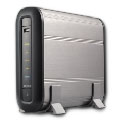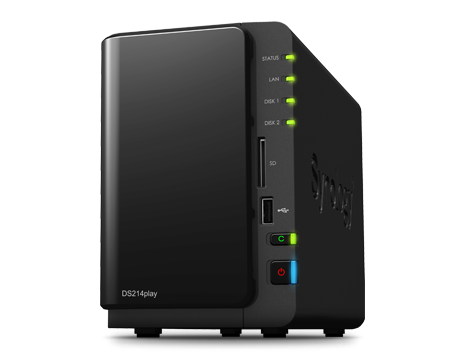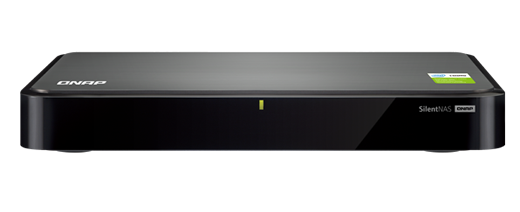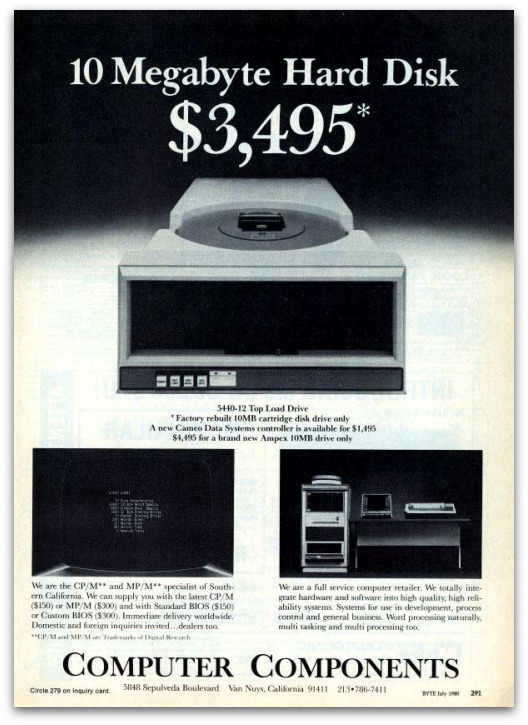- Connecting audio
- Audio PC
- Raspberry & Co
- All in Ones
- Bluetooth
- Chromecast
- Streaming audio player
- Music server
- USB Audio
- Real-time audio over IP
- FireWire DAC
- Multi-channel DAC
- NAS
- Remote control
- Vinyl rippers
- Acoustic materials
- Active crossover
- Active speakers
- Single driver speakers
- Invisible speakers
- Sound card
- Digital room correction
- Headphone
- Portable media players
NAS

Network Attached Storage is a computer connected to the network.
In the past its function was to store and share files over the network.
Today it comes bundled with a lot more functionality.
In general a NAS is:
- headless (no screen, mouse, keyboard)
- low on power consumption,
- low noise
Talking entry level NAS here as there are also very powerful ones around.
For audio you don’t need a fast one.
Most of the time, a NAS is a computer running Linux.
Often it comes with a web interface allowing you to control the box without Linux knowledge.
A lot of people struggle using a NAS.
They plug it in and then what's next?
If you want to access files (file sharing) on a NAS over the network you have to do a couple of things.
- Make users. These are local users only known to the NAS.
Even if the username on the NAS is identical to the username on your PC, it remains a local Linux user and Windows simply won’t recognize it.
- Make shares. These are the folders you are going to access (to share) over the network.
- Add users to the shares and specify their rights.
- You probably have to activate network services (SMB) on the NAS as well.
- On your PC connect to a share using the credentials of one of the NAS user’s you have created. Windows allows you to connect to multiple shares on a NAS but with one user only.
RAID
Multi bay models can be configured as RAID
RAID1 (mirroring) is a popular solution.
It requires 2 HDs only and the 2nd is a copy of the first.
If one drive fails you and you buy the replacement in time, the NAS will faithfully synchronize the 2.
But what if e.g. the controller of the NAS fails you.
Can you mount these drives in another NAS without formatting?
What in case of theft, fire or simple dropping the unit (cats, children, a beer to many)?
Not to mention the most common disaster, cockpit errors.
You screw up your tagging massively, delete the wrong files, etc.
Than you will notice that all your errors are faithfully replicated from one drive to the other and no way to roll back.
RAID is about high availability, not to be mistaken for a backup!
I recommend you get an external USB-HD (modern NAS do support this), make a backup and store this in a save place.
Because inevitably there will come a day you say to yourself "I should have made a backup".
NAS or external Hard Disk
An external HD is the easier of the two. Just connect it to your PC and you are up and running.
A NAS is adding another computer to your network.
You have to make shares, add users and give the users access rights to the shares.
If you are in to streaming, you have to configure the DLNA as well.
A NAS can be placed anywhere, out of sight and out of hearing.
In general it is frugal on energy so you leave it on 7x24.
Functionality
A modern NAS offers more functionality than file sharing only.
File server
This is the original use of a NAS.
A cheap solution to allow users to share files over the network.
Multimedia server
Today a NAS is often used as a multimedia server.
- DLNA compliant multimedia server.
This is the industry standard for multimedia.
Check user forums before you buy. A lot of this software is very buggy and/or cracks under load. Look for DLNA certified products. - LMS
Although Logitech killed the Squeezebox long ago, Logitech Media Server is still a popular platform.
A must if you use Squeezeboxes. - iTunes server
- AirPlay
Download
Download files using Torrent or HTTP
FTP-server, Webserver, MySql
All you need to host your own website.
Personal Cloud
Accessing your data over the internet.
Router
Modern routers allows you to add an external HD.

Asus RT-AC66U
Router with 2 USB ports.
Services: UPnP, iTunes, FTP and SAMBA.
Add a external USB drive and you have your entry level NAS and a router at the same time.
NAS
Synology

Part of the interface (DiskStation) is the Audio Station.
Audio Station supports streaming music to computers, USB speakers, media renderers, AirPlay or Bluetooth devices.
You can even attach an USB-DAC.
QNAP HS-251+

A fanless design. Populate it with SSD's for a silent operation.
HDMI output and a remote control.
You can centrally manage and stream photos, music and videos from the HS-251+ to different rooms from a single device using Bluetooth® & USB devices connected to the HS-251+ (for music streaming only), HDMI, DLNA®, Apple TV® and Chromecast™


